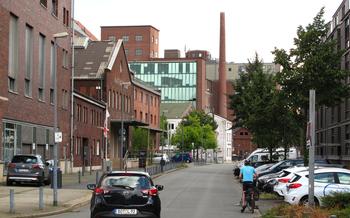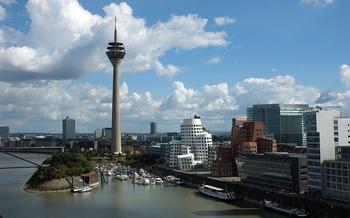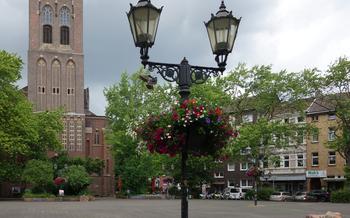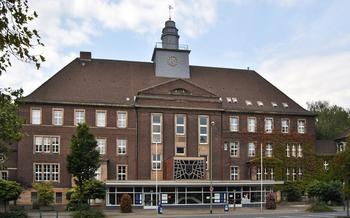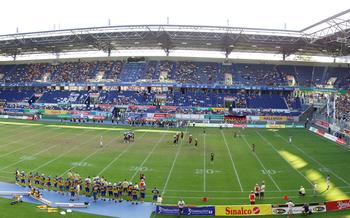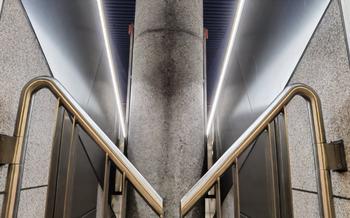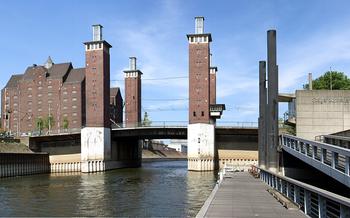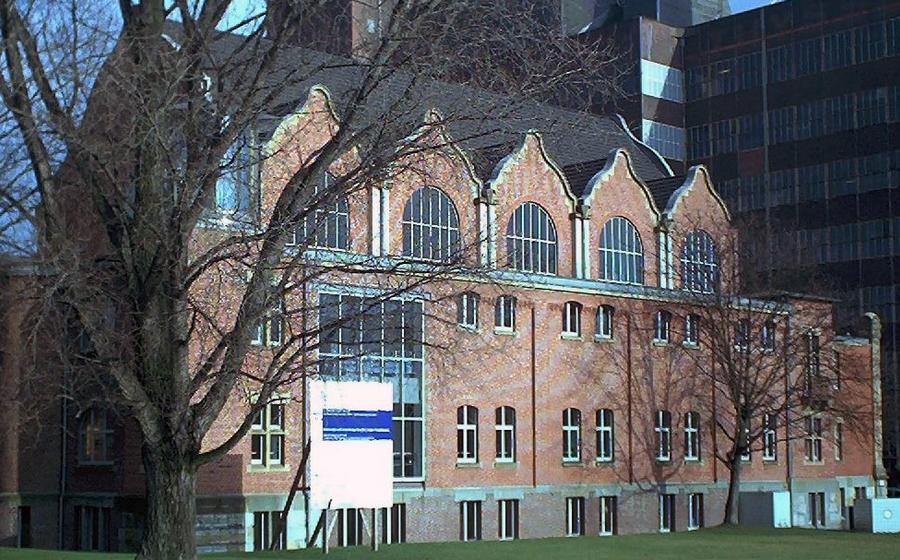
Binnenschifffahrtsmuseum
- A Trip to the Binnenschifffahrtsmuseum
- A Journey Through Inland Waterways:
- The Allure of the Mighty Rhine
- A Showcase of Engineering Marvels
- Navigating the Challenges of Inland Shipping
- Life Aboard the Inland Waterways
- A Glimpse into the Future of Inland Shipping
- Interactive Experiences for Visitors
- A Voyage Through History: Unveiling the Maritime Heritage of Inland Shipping
- Events and Exhibitions at the Museum
- The Museum Shop: A Treasure Trove of Inland Shipping Memorabilia
- The Museum's Contribution to Inland Shipping History
- Practical Information for Visitors:
- Insider Tip: Discover the Hidden Gems of the Museum
A Trip to the Binnenschifffahrtsmuseum
Nestled in the heart of Duisburg, Germany, the Binnenschifffahrtsmuseum stands as a testament to the rich history of inland shipping in Germany. Established in 1979, the museum offers visitors a captivating journey through the world of inland waterway transportation, showcasing its historical significance and ongoing impact on the region's economy and culture. Located in the historic Ruhrort district, the museum is easily accessible by public transportation and offers ample parking for visitors arriving by car. Operating hours vary throughout the year, but the museum is generally open from Tuesday to Sunday, with extended hours during the summer months. Admission fees are reasonable, with discounts available for students, seniors, and families. Guided tours are available upon request, providing visitors with a deeper understanding of the exhibits and the history of inland shipping in Germany. Educational programs are also offered for schools and groups, making the museum an excellent resource for learning about this fascinating aspect of German history and culture.
A Journey Through Inland Waterways:
The Binnenschifffahrtsmuseum's collection takes visitors on a captivating journey through the history of inland shipping in Germany. Through an array of exhibits, interactive displays, and multimedia presentations, the museum showcases the evolution of this vital mode of transportation.
Historical Exhibits: Delve into the rich history of inland shipping, tracing its roots back to the early days of trade and commerce along Germany's rivers and canals. Discover the challenges faced by early boatmen and the technological advancements that revolutionized the industry.
Interactive Displays: Engage with interactive exhibits that bring the history of inland shipping to life. Simulate navigating a ship through virtual waterways, test your knowledge with interactive quizzes, and explore the inner workings of locks and canals.
Multimedia Presentations: Immerse yourself in multimedia presentations that showcase the beauty and diversity of Germany's inland waterways. Watch captivating footage of ships traversing the Rhine River, learn about the unique culture of inland waterway workers, and witness the engineering marvels that make inland shipping possible.
Artifacts and Models: Marvel at a vast collection of artifacts and models that depict the evolution of inland waterway transportation. From intricate scale models of historic vessels to full-size replicas of traditional barges, these exhibits provide a tangible connection to the past.
The Allure of the Mighty Rhine
The Rhine River, a vital artery coursing through the heart of Europe, has played a pivotal role in shaping Germany's inland waterways. Its majestic waters have borne witness to the rise and fall of civilizations, the ebb and flow of trade, and the industrial transformation of the Rhine-Ruhr region. The Binnenschifffahrtsmuseum Duisburg pays homage to this mighty river, shedding light on its profound impact on the region's economy, culture, and way of life.
The Rhine's strategic location, connecting the North Sea to the heart of Europe, has made it a crucial trade route since ancient times. The Romans recognized its significance, establishing trading posts and military fortifications along its banks. During the Middle Ages, the Rhine became a bustling waterway, with merchants from across Europe plying its waters, transporting goods and fostering cultural exchange.
In the 19th century, the Rhine-Ruhr region underwent a dramatic transformation, fueled by the Industrial Revolution and the rise of heavy industry. Coal mines, steel mills, and factories sprang up along the river's banks, transforming the region into one of the most industrialized areas in the world. The Rhine became a lifeline for industry, transporting raw materials and finished goods between factories, ports, and markets.
The influence of the Rhine River extended beyond the realm of economics. Its scenic beauty and cultural significance inspired artists, writers, and musicians. The river's romantic allure captured the imagination of generations, immortalized in paintings, poems, and songs. The Rhine became a symbol of Germany's rich history, natural wonders, and industrial prowess.
A Showcase of Engineering Marvels
The Binnenschifffahrtsmuseum Duisburg not only delves into the history of inland shipping but also showcases the remarkable engineering feats that have shaped inland waterways. Exhibits highlight the ingenuity and innovation behind locks, canals, and bridges, which have transformed the landscape and facilitated the movement of goods and people.
Locks and Canals: The museum features intricate models and interactive displays that demonstrate the operation of locks and canals. Visitors can learn about the engineering principles that allow ships to navigate different water levels, overcoming obstacles and connecting waterways.
Bridges: The museum also showcases the architectural and engineering marvels of bridges that span rivers and canals. From historic iron bridges to modern suspension bridges, these structures have played a vital role in connecting communities and facilitating transportation.
Model Ships and Historical Maps: The museum's collection includes a variety of model ships, from replicas of historic vessels to contemporary inland waterway vessels. These models provide a glimpse into the evolution of ship design and construction. Historical maps and charts further illustrate the development of inland waterways and the changing landscape over time.
Interactive Displays: Interactive displays at the museum allow visitors to engage with the principles of inland waterway navigation. Visitors can simulate navigating a ship through virtual waterways, experiencing the challenges and decision-making involved in operating a vessel. These interactive exhibits provide a hands-on understanding of the complexities of inland shipping.
Navigating the Challenges of Inland Shipping
Inland waterway transportation, despite its many advantages, faces a number of obstacles and challenges. Natural factors, such as weather conditions and fluctuating water levels, can significantly impact the safety and efficiency of inland shipping operations. Adverse weather conditions, such as storms, fog, and heavy rainfall, can lead to reduced visibility, increased wave action, and strong currents, making navigation difficult and hazardous. Similarly, variations in water levels due to seasonal changes, droughts, or floods can affect the depth of waterways, posing challenges to vessels' passage and requiring careful planning and adjustments to routes.
Navigational hazards, such as shallow waters, narrow passages, and bridge clearances, also pose risks to inland waterway transportation. These obstacles require careful maneuvering and precise navigation to avoid groundings, collisions, and damage to vessels or infrastructure. To ensure the safety of navigation, inland waterways are equipped with various aids, including buoys, markers, and traffic signals, which help guide vessels and prevent accidents.
In addition, inland waterway transportation must contend with various safety measures and regulations aimed at minimizing risks and protecting the environment. These regulations cover aspects such as vessel design, equipment requirements, crew qualifications, and cargo handling procedures. Compliance with these regulations is essential for ensuring the safety of inland waterway operations and preventing accidents, pollution, and damage to ecosystems.
Life Aboard the Inland Waterways
The Binnenschifffahrtsmuseum offers a glimpse into the unique world of inland waterway workers, shedding light on their daily lives and the challenges they faced. Exhibits showcase the living quarters and working conditions on board, providing visitors with a palpable sense of the hardships and camaraderie that defined life on the waterways. Through personal stories and anecdotes from former inland waterway workers, the museum brings to life the rich culture and traditions of this resilient community. Visitors can immerse themselves in the experiences of those who spent their lives navigating the rivers and canals of Germany, gaining a deeper appreciation for the dedication and determination required to succeed in this demanding profession.
A Glimpse into the Future of Inland Shipping
The Binnenschifffahrtsmuseum not only delves into the rich history of inland shipping but also casts a visionary gaze into its future. The museum showcases sustainable and innovative practices that are shaping the industry's trajectory.
Visitors can explore exhibits dedicated to the use of alternative fuels, such as liquefied natural gas (LNG) and biofuels, which reduce emissions and contribute to a greener future for inland waterway transportation. The museum also highlights the role of technology in revolutionizing the industry, with exhibits on digitalization, automation, and the use of artificial intelligence in navigation and cargo handling.
Environmental protection is a key theme at the Binnenschifffahrtsmuseum. Visitors can learn about the impact of inland shipping on ecosystems and the measures taken to minimize this impact, including the use of eco-friendly technologies and the promotion of sustainable practices.
The museum also explores the future challenges and opportunities facing the inland shipping industry. These include the impact of climate change on water levels and navigation, the need for infrastructure improvements, and the increasing demand for sustainable transportation solutions.
Through its exploration of these themes, the Binnenschifffahrtsmuseum provides visitors with a glimpse into the exciting future of inland waterway transportation, showcasing the industry's commitment to innovation, sustainability, and environmental stewardship.
Interactive Experiences for Visitors
The Binnenschifffahrtsmuseum offers a wealth of interactive experiences that allow visitors to immerse themselves in the world of inland shipping. Hands-on activities and interactive displays provide a deeper understanding of the challenges and rewards of inland waterway transportation. Visitors can simulate navigating a ship through virtual waterways, testing their skills and learning about the complexities of river navigation. Multimedia presentations and educational games bring the history and culture of inland shipping to life, engaging visitors of all ages. The museum's commitment to interactive learning ensures that visitors leave with a lasting appreciation for the significance of inland waterways in Germany's past, present, and future.
A Voyage Through History: Unveiling the Maritime Heritage of Inland Shipping
The Binnenschifffahrtsmuseum boasts an impressive collection of historic vessels and artifacts that take visitors on a captivating journey through the evolution of inland shipping. From meticulously preserved barges and tugboats to intricate models showcasing the ingenuity of shipbuilding, the museum offers a glimpse into the rich maritime heritage of Germany's inland waterways.
Exhibits at the museum showcase the evolution of shipbuilding techniques, from traditional wooden construction to modern steel vessels. Visitors can marvel at the craftsmanship and engineering that went into creating these remarkable vessels, which played a crucial role in shaping the history of inland shipping.
The museum's dedication to preserving and restoring inland waterway heritage is evident in the meticulous care taken to maintain these historic vessels. Through ongoing restoration projects, the museum ensures that these iconic symbols of the past remain accessible to future generations.
By preserving and showcasing the cultural significance of inland shipping, the Binnenschifffahrtsmuseum plays a vital role in promoting the understanding and appreciation of this important aspect of Germany's history and identity.
Events and Exhibitions at the Museum
The Binnenschifffahrtsmuseum is not just a static display of inland shipping history; it's a vibrant hub of activity that hosts a variety of events and exhibitions throughout the year. These events are designed to engage and educate visitors of all ages, providing a dynamic and immersive experience.
Regular events, workshops, and exhibitions are held at the museum, offering something for everyone. From hands-on activities for families to informative lectures and presentations for enthusiasts, there's always something new to discover.
Special programs are tailored for specific audiences, such as families, schools, and groups. These programs provide a unique opportunity for visitors to delve deeper into the world of inland shipping, with guided tours, interactive workshops, and educational games.
Temporary exhibitions showcase specific aspects of inland waterway history, presenting a diverse range of topics and perspectives. These exhibitions often feature unique artifacts, historical documents, and multimedia presentations, providing visitors with a fresh and engaging experience.
Through these events and exhibitions, the Binnenschifffahrtsmuseum strives to provide a dynamic and engaging experience that keeps visitors coming back for more. It's a place where history comes alive, and the spirit of inland shipping continues to thrive.
The Museum Shop: A Treasure Trove of Inland Shipping Memorabilia
The Binnenschifffahrtsmuseum also boasts a well-stocked museum shop, a treasure trove of inland shipping memorabilia and souvenirs. Here, visitors can delve deeper into the world of inland waterways through a diverse selection of items, including model ships, postcards, books, and other collectibles. These unique pieces make for cherished mementos of the museum visit and serve as tangible reminders of the rich history and cultural significance of inland shipping. The museum shop also contributes to the museum's educational mission by offering a range of publications, allowing visitors to further explore the fascinating world of inland waterway transportation.
The Museum's Contribution to Inland Shipping History
The Binnenschifffahrtsmuseum is not merely a repository of artifacts and displays; it is an active contributor to the preservation, documentation, and dissemination of inland shipping history. The museum's dedicated staff conducts extensive research on various aspects of inland waterway transportation, resulting in publications, articles, and books that enrich the field of inland shipping studies. Collaborations with other museums, universities, and institutions further enhance the museum's impact, fostering a global network of knowledge exchange and cooperation.
Through its ongoing research and educational initiatives, the museum plays a crucial role in raising awareness about the significance of inland waterway transportation. It highlights the industry's contributions to economic development, cultural heritage, and technological innovation, ensuring that the legacy of inland shipping remains vibrant and accessible to future generations. The museum's commitment to preserving and promoting inland shipping history extends beyond its walls, as it actively engages with the community through outreach programs, lectures, and workshops, inspiring a new generation of enthusiasts and researchers to delve deeper into this fascinating field.
Practical Information for Visitors:
The Binnenschifffahrtsmuseum is committed to providing a welcoming and accessible experience for all visitors. Accessibility features such as ramps, elevators, and audio guides for the visually impaired are available to ensure that everyone can enjoy the museum's exhibits. Facilities such as a cafeteria, lockers, and restrooms are available for the convenience of visitors.
Parking options are available near the museum, including both on-street parking and parking garages. Visitors are encouraged to use public transportation whenever possible, as the museum is well-connected by bus and tram lines.
For further information and online ticketing, please visit the museum's website. The museum staff is always happy to assist visitors with any questions or inquiries.
Insider Tip: Discover the Hidden Gems of the Museum
To fully immerse yourself in the world of inland shipping, venture beyond the main exhibition halls and uncover the hidden gems of the Binnenschifffahrtsmuseum. Explore the museum's outdoor exhibits, where you'll find a collection of historic vessels, including an authentic replica of a traditional wooden sailing barge. These vessels offer a glimpse into the past and provide a unique perspective on the evolution of inland waterway transportation.
Take advantage of the guided tours offered by the museum to gain a deeper understanding of the exhibits and the history of inland shipping. Knowledgeable guides will share fascinating stories and anecdotes, bringing the museum's collection to life. Guided tours are available in various languages and can be booked in advance or upon arrival.
Attend special events and workshops organized by the museum throughout the year. These events offer a unique opportunity to engage with experts, participate in hands-on activities, and learn about specific aspects of inland waterway history and culture. Check the museum's website or social media pages for upcoming events and workshops.
Finally, don't hesitate to engage with the museum's friendly and knowledgeable staff. They are passionate about inland shipping and are always happy to share their expertise and provide personalized recommendations. Whether you have a specific interest or simply want to learn more, the museum staff is there to assist you and make your visit a memorable one.
